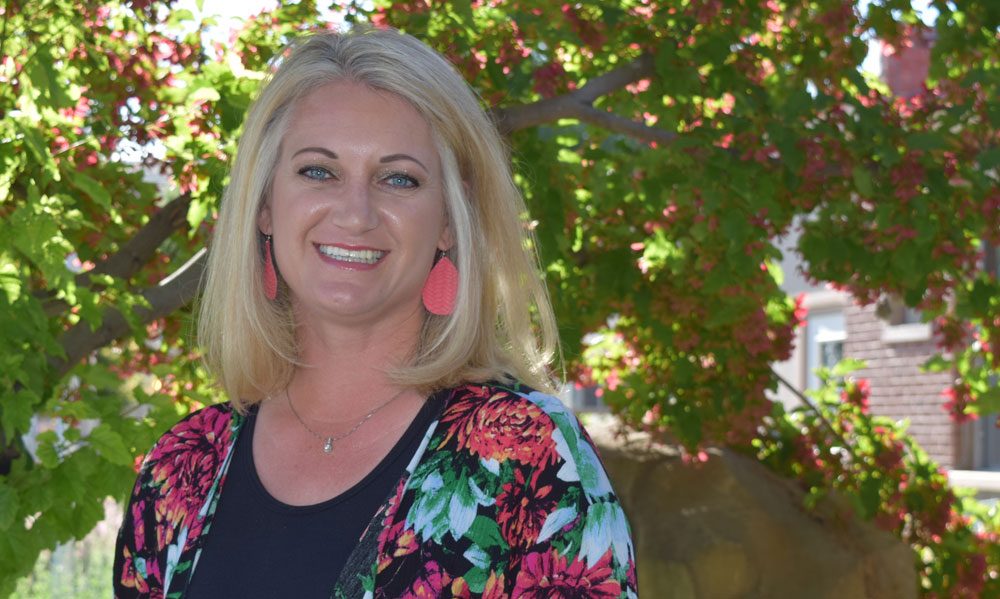 Alisha McBride, Vale school district superintendent, and school board members are working toward new goals for improving student performance – especially in math – and bolstering services that will help reduce absenteeism. (The Enterprise/Yadira Lopez)
Alisha McBride, Vale school district superintendent, and school board members are working toward new goals for improving student performance – especially in math – and bolstering services that will help reduce absenteeism. (The Enterprise/Yadira Lopez)
VALE – Many viewed Alisha McBride as a savior when she was appointed over a year ago to lead the Vale School District.
Her promotion followed the sudden resignation of superintendent Scott Linenberger in 2017 and the tenure of interim superintendent James Howard in 2018. She was serving as the interim superintendent when she proved to the board that she was capable of redirecting the Vale School District as a stable leader and was appointed to the helm in January 2018. Just over a year later, McBride’s determination has given way to passion and collaboration.
She spearheaded a team of leaders of faculty and staff to work with the school board on revising the district’s vision and mission.
With the work done, she has steps she wants to take.
She wants to improve student test scores, bolster teacher recruitment and training, and add creative arts and music on the curriculum. The district serves roughly 925 students.
Last year, she took to the board a plan to get help through the Oregon School Boards Association.
The association’s Oregon Scholarship Program provides school districts with training to restructure the school board’s planning process and get help from teachers, administrators, district staff and board members.
“We kind of had an idea that we wanted to do redo our goals and this program had a good outline with basic steps on how to do that,” said Randy Seals, Vale school board president. “We also thought it was important to get everyone on the same page.”
Seals said the school board met monthly with a team of district staff and attended several workshops hosted by the school boards association.
“The whole point of doing this program is to get the board and school district aligned with supporting common goals,” Seals said. “The district and the school board may have different views. The people on the board might not necessarily be educators, so they have different goals from those who work in education. This is a way for us to all be on the same page, that we all work together in the process.”
Over the course of several months, McBride said district leaders identified areas that needed more improvement.
“The team spent over 50 hours looking at data. There wasn’t just one statistic, it was a comprehensive analysis of data, student demographic and student performance,” said McBride. “As we looked at that data, needs began to emerge. Once we identified those needs, new goals emerged.”
One goal is to improve math performance. State data showed Vale students consistently performed below the state average.
“We perform well in our language arts scores, but we noticed that that math was always lower,” McBride said. “We look at different state data. For example, we look at the data from the state average, comparable schools and schools with similar demographics. It depends what you look at, but if you look at the district report cards and compare them to the state, our math scores have been lower.”
In the last four years, 33 percent of Vale students showed proficiency in math, compared to the state average of 40 percent. During the 2017-18 school year, 37 percent of Vale students met the state’s standards, compared to 41 percent at the state.
“What we’re saying is that we are not OK with 36 to 37 percent meeting or exceeding the state expectations. We want to increase that. We are constantly looking to improve performance data, and mathematics was identified as that area that needed improvement,” McBride said.
The district also wants to increase access to mental health care to reduce chronic absenteeism and improve student performance in the classroom.
“We’re seeing more students coming to school with higher needs,” McBride said. “We’re seeing more students with needs because of trauma, which could be from abuse, neglect or accident.”
The district has incorporated trauma informed training.
“Across the nation, research shows that children are exposed to trauma more than before,” McBridge said. “Ten years ago we didn’t have trauma informed care training.”
McBride said, for example, if a student is acting out, one approach is to try to figure out the underlying problem that provoked the student.
“It’s not that we’re addresses the actual problem. We are providing instructional support by teaching coping skills – teaching students how to work through problems,” McBride said. “For example, if a kindergartener experiences a dilemma on the playground, we tell them to think ‘What are my options? Can I just walk away? Ask the student to stop?’ We try to help students by teaching them these coping skills.”
McBride said the district is also adding a second counselor to its staff. Instead of having one counselor to work with students district wide, one will be stationed at the high school and the second one will work with K-8 students.
McBride said such changes could decrease student discipline referrals, higher attendance rates and possibly lower dropout rates.
“I would say we do not have excessive discipline referrals. If we have a student that’s acting out because he or she is having problems at recess, that student is going to be referred to office,” McBride said. “The purpose of implementing more access to support is to reduce those types of reactions that lead to referrals. We want to teach students these skills on how to deal with situations that could lead to disciplinary consequences.”
The district also wants to provide more support to its faculty and staff as a way to avoid teacher burnout and absenteeism.
“There’s no concern with staff attendance. It’s more related to trauma-informed care. For example, if there’s a teacher that’s always battling disruptive students, it just takes a toll on an adult,” McBride said. “Trauma informed care research show that teachers and staff take on a lot – we experience a lot. When our students are experiencing troubles, there’s correlation that it is overwhelming for staff.”
McBride said the goal is to boost staff morale so employees want to go to work.
“There were other needs that we identified, but with our available resources we decided that addressing these would be the most feasible,” said McBride.
Reporter Kristine de Leon: [email protected] or 541-473-3377.
SUBSCRIBE TO HELP PRODUCE VITAL REPORTING — For $5 a month, you get breaking news alerts, emailed newsletters and around-the-clock access to our stories. We depend on subscribers to pay for in-depth, accurate news produced by a professional and highly trained staff. Help us grow and get better with your subscription. Sign up HERE.




